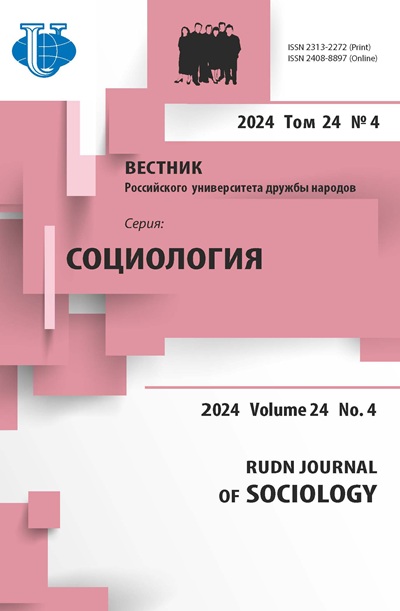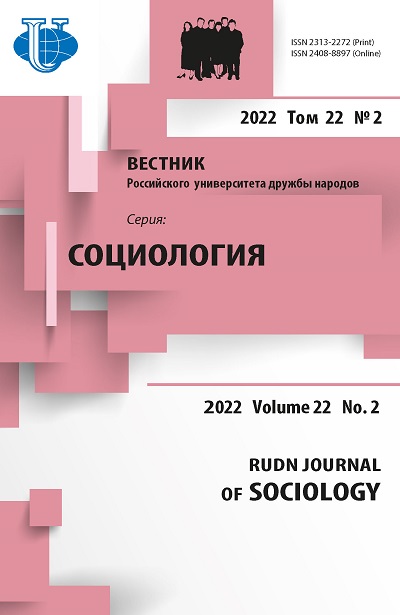Двухкомпонентная модель факторов поведения: феномен упреждающего вовлечения ситуационно доминирующего фактора
- Авторы: Чернозуб О.Л.1, Терешкин С.И.1
-
Учреждения:
- Институт исследований социального действия
- Выпуск: Том 22, № 2 (2022)
- Страницы: 259-274
- Раздел: Вопросы истории, теории и методологии
- URL: https://journals.rudn.ru/sociology/article/view/31342
- DOI: https://doi.org/10.22363/2313-2272-2022-22-2-259-274
Цитировать
Полный текст
Аннотация
Одним из дискуссионных вопросов в теории социального действия выступает взаимодействие эксплицитных и имплицитных факторов в их влиянии на поведение человека. «Параллельные» модели влияния противостоят «последовательным»: первые утверждают, что один фактор порождает другой, и последний влияет на поведение; вторые - что факторы носят независимый характер и влияют на поведение каждого по-своему. В практическом плане согласие с одной из этих моделей означает отказ или принятие возможности конфликта факторов и трактовки поведения как результата этого конфликта. Ранее мы выяснили, что характер влияния идеологически предвзятых высказываний на эксплицитные и имплицитные компоненты установки к объекту этих высказываний может быть прямо противоположным, - теперь логично проверить, насколько это явление устойчиво. Если это так, то необходимо будет признать независимую природу факторов поведения. Такая проверка была проведена и (в рамках использованного эмпирического материала) подтвердила правильность «параллельных» моделей. Этот вывод тем более убедителен, что был получен путем наблюдения за динамикой ассоциаций между компонентами отношения и предполагаемыми факторами его формирования. По мере повышения критичности респондентов характер этих отношений предсказуемо меняется, но для эксплицитной и имплицитной компонент установки он меняется по-разному. Более того, мы столкнулись с феноменом, который назвали «упреждающим задействованием ситуационно доминирующего фактора» познания. Если мы не ошибаемся в понимании его природы, то основы теорий «последовательного» влияния оказываются под вопросом.
Об авторах
Олег Леонидович Чернозуб
Институт исследований социального действия
Email: 9166908616@mail.ru
кандидат социологических наук, председатель научно-технического совета
2-ой Щемиловский пер., 2, Москва, 127055, РоссияСергей Иванович Терешкин
Институт исследований социального действия
Автор, ответственный за переписку.
Email: s.tereshkin@gmail.com
председатель правления
2-ой Щемиловский пер., 2, Москва, 127055, РоссияСписок литературы
- Chernozub O.L. Revealing the affective component of the electoral attitude: Creation and validation of a graphic associative test of the attitude. Monitoring of Public Opinion: Economic and Social Changes. 2018; 3.
- Chernozub O.L. Electoral forecasting based on data on intentions: Limits of accuracy of the conventional model and prospects for its development based on emotional factors. Monitoring of Public Opinion: Economic and Social Changes. 2018; 4.
- Chernozub O.L. Implicit factors and inconsistency of electoral behavior: From a theoretical concept to an empirical phenomenon. Monitoring of Public Opinion: Economic and Social Changes. 2020; 4.
- Chernozub O.L. Implicit factors and inconsistency of electoral behavior: From attitude to behavior. Monitoring of Public Opinion: Economic and Social Changes. 2020; 5.
- Chernozub O.L. The two-component model of behavior factors: Evidences of orthogonality of explicit and implicit factors. RUDN Journal of Sociology. 2022; 1.
- Cluster D. What is critical thinking? Critical Thinking and New Types of Literacy. Moscow; 2005.
- Conner M.T., Perugini M., O`Gorman R., Ayres K., Prestwich A. Relations between implicit and explicit measures of attitudes and measures of behavior: Evidence of moderation by individual difference variables. Personality and Social Psychology Bulletin. 2007; 33 (12).
- Dasgupta N., Rivera L.M. From automatic antigay prejudice to behavior: The moderating role of conscious beliefs about gender and behavioral control. Journal of Personality and Social Psychology. 2006; 91 (2).
- Dewey D. Psychology and Pedagogy of Thinking. Moscow; 1997.
- Facione P.A. Critical Thinking: What It Is and Why It Counts. PhD Thesis; 2017.
- Fazio R. Attitudes as object-evaluation associations of varying strength. Social Cognition. 2007; 25 (5).
- Fazio R. The role of attitudes in memory-based decision making. Journal of Personality and Social Psychology. 1990; 59 (4).
- Fazio R., Olson M. The MODE model: Attitude-behavior processes as a function of motivation and opportunity. Dual Process Theories of the Social Mind. New York; 2014.
- Fazio R.H., Jackson J.R., Dunton B.C., Williams C.J. Variability in automatic activation as an unobstrusive measure of racial attitudes: A bona fide pipeline? Journal of Personality and Social Psychology. 1995; 69 (6).
- Florack A., Scarabis M., Bless H. When do associations matter? The use of automatic associations toward ethnic groups in person judgments. Journal of Experimental Social Psychology. 2001; 37 (6).
- Fong G.T., Krantz D., Nisbett R.E. The effects of statistical training on thinking about everyday problems. Cognitive Psychology. 1986; 18.
- Foundation for Critical Thinking. URL: http://www.criticalthinking.org/pages/definingcritical-thinking/766.
- Gawronski B., LeBel E.P. Understanding patterns of attitude change: When implicit measures show change, but explicit measures do not. Journal of Experimental Social Psychology. 2007; 44 (5).
- Glaser E.M. An Experiment in the Development of Critical Thinking. Columbia University Press; 1941.
- Halpern D. Psychology of Critical Thinking. Saint Petersburg; 2000.
- Jordan C.H., Whitfield M., Zeigler-Hill V. Intuition and the correspondence between implicit and explicit self-esteem. Journal of Personality and Social Psychology. 2007; 93 (6).
- Kendrick R.V., Olson M.A. When feeling right leads to being right in the reporting of implicitlyformed attitudes, or how I learned to stop worrying and trust my gut. Journal of Experimental Social Psychology. 2012.
- Koole S.L., Dijksterhuis A., van Knippenberg A. What’s in a name: Implicit self-esteem and the automatic self. Journal of Personality and Social Psychology. 2001; 80.
- Lehman D.R., Lempert R.O., Nisbett R.E. The effects of graduate training on reasoning: Formal discipline and thinking about everyday-life events. American Psychologist. 1988.
- Lehman D.R., Nisbett R.E. A longitudinal study of the effects of undergraduate training on reasoning. Developmental Psychology. 1990; 26.
- Newson R. Parameters behind ‘nonparametric’ statistics: Kendall’s tau, Somers’ D and median differences. Stata Journal. 2002; 2 (1).
- O`Connell A.A. Logistic Regression Models for Ordinal Response Variables. Sage Publications; 2006.
- Paul R., Elder L. The Critical Thinking Reading and Writing Test. Foundation for Critical Thinking; 2006.
- Paul R., Elder L. The Miniature Guide to Critical Thinking Concepts and Tools. Foundation for Critical Thinking Press; 2008.
- Perugini M. Predictive models of implicit and explicit attitudes. British Journal of Social Psychology. 2005.
- Perugini M., Richetin J., Zogmaister C. Prediction of behavior. Handbook of Implicit Social Cognition: Measurement, Theory, and Applications. Guilford Press; 2010.
- Ranganath K.A., Smith C.T., Nosek B.A. Distinguishing automatic and controlled components of attitudes from direct and indirect measurement methods. Journal of Experimental Social Psychology. 2008; 44.
- Schoenfeld A.H., Herrmann D.J. Problem perception and knowledge structure in expert and novice mathematical problem solvers. Journal of Experimental Psychology: Learning, Memory and Cognition. 1982; 5.
- Shuman A.N. Modern Logic: Theory and Practice. Minsk; 2004.
- Somers R.H. A new asymmetric measure of association for ordinal variables. American Sociological Review. 1962; 27 (6).
- Strack F., Deutsch R. Reflective and impulsive determinants of social behavior. Personality and Social Psychology Review. 2004; 8.
- Strack F., Neumann R. Furrowing the brow may undermine perceived fame: The role of facial feedback in judgments of celebrity. Personality and Social Psychology Bulletin. 2000; 26.
Дополнительные файлы














